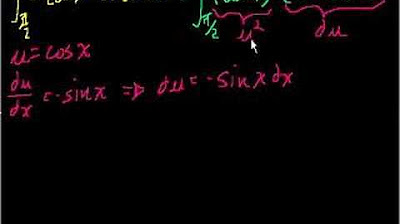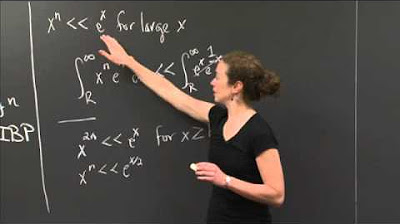Proof Of The Basel Problem
TLDRThis video explores Euler's proof of the Basal problem, which equates the sum of 1/n^2 from n=1 to infinity with pi squared divided by 6. The proof begins with the Maclaurin expansion of sin(x)/x and transitions to the Weierstrass Factorisation Theorem, expressing sin(x) as a product of its roots. By examining the pattern of these roots and comparing coefficients, the video demonstrates the equivalence of the series to the Riemann zeta function at 2, ultimately revealing the elegant relationship between the series and pi squared over 6.
Takeaways
- 📚 The video discusses a proof of the Basal problem, which was first proved by Euler in 1730.
- 🧩 The Basal problem states that the sum of 1/n^2 from n=1 to infinity equals pi squared divided by 6, which is also the Riemann zeta function evaluated at 2.
- 🔍 The proof begins by considering the sine function and its Maclaurin expansion, dividing by x to get a series that resembles the sum we want to prove.
- 📐 The script introduces the Weierstrass Factorisation Theorem to express sin(x) as a product of its roots, which are integer multiples of π.
- 🔄 By dividing the product by x, the script derives an expression for sin(x)/x as an infinite product involving pairs of terms (x+nπ)(x-nπ).
- 🔢 The difference of squares property is used to simplify each pair into x^2 - n^2π^2, leading to a series that can be related to the original sum.
- 🔍 The script observes that by factoring out constants from the series, we can rewrite the expression for sin(x)/x in a form that highlights the coefficients we are interested in.
- 🔄 The script then multiplies the terms of the series to derive an expression that resembles the sum of 1/n^2, and identifies a pattern involving powers of π squared.
- 🔗 By comparing coefficients from two different expansions of sin(x)/x, the script establishes an equivalence that leads to the conclusion of the Basal problem.
- ⚖️ The final step involves multiplying both sides of the derived equation by π^2 to equate the sum of 1/n^2 to π^2/6, completing the proof.
- 🌟 The video script provides a detailed and methodical approach to proving the Basal problem, involving both trigonometric functions and series manipulation.
Q & A
What is the Basal problem and who proved it?
-The Basal problem, also known as the Basel problem, states that the sum of the reciprocals of the squares of the natural numbers from 1 to infinity is equal to π²/6. It was proved by the Swiss mathematician Leonhard Euler in about 1730.
What is the connection between the Basal problem and the Riemann zeta function?
-The Basal problem is related to the Riemann zeta function, specifically ζ(2), which is the sum of the reciprocals of the squares of the natural numbers. The solution to the Basal problem is equivalent to evaluating the Riemann zeta function at 2.
Why does the script mention the Maclaurin expansion of sin(x)?
-The Maclaurin expansion of sin(x) is used as a starting point in the proof of the Basal problem. It is a series expansion that is manipulated to eventually relate to the sum of the reciprocals of the squares of the natural numbers.
What is the significance of dividing the Maclaurin expansion of sin(x) by x?
-Dividing the Maclaurin expansion of sin(x) by x transforms it into a series that resembles the sum we are trying to evaluate in the Basal problem. This transformation is a crucial step in the proof.
What is the Weierstrass Factorisation Theorem mentioned in the script?
-The Weierstrass Factorisation Theorem is a mathematical theorem that allows a function to be expressed as a product of its roots. In the context of the script, it is used to express sin(x) as a product involving its roots at integer multiples of π.
How does the script use the roots of sin(x) to rewrite it as a product?
-The script uses the fact that sin(x) has roots at x = nπ for all integers n. By applying the Weierstrass Factorisation Theorem, sin(x) is rewritten as a product of terms (x + nπ)(x - nπ), which simplifies to (x^2 - n^2π^2) when divided by x.
What is the pattern observed when multiplying the pairs of terms in the product expansion of sin(x)/x?
-The pattern observed is that each pair of terms multiplies to a form of (x^2 - n^2π^2), which is a difference of squares. This pattern is key to simplifying the product and eventually relating it to the sum of the reciprocals of the squares of the natural numbers.
Why is factoring out -π^2 from the terms in the product expansion useful?
-Factoring out -π^2 from the terms allows for a simplification that makes it easier to compare the product expansion of sin(x)/x with its Maclaurin expansion. This step is crucial for equating the two expressions and comparing coefficients.
How does the script relate the coefficients of the x^2 term in the two expansions of sin(x)/x?
-By equating the coefficients of the x^2 term from the Maclaurin expansion (1/6) with the corresponding terms from the product expansion, the script establishes a relationship between the sum of the reciprocals of the squares of the natural numbers and the series involving π^2.
What is the final step in the proof outlined in the script?
-The final step is to multiply both sides of the equation that equates the sum of the reciprocals of the squares of the natural numbers to the series involving π^2 by π^2, which yields the final result that π^2/6 is equal to the sum from one to infinity of one over n^2.
Outlines
📚 Introduction to the Basal Problem and Euler's Proof
The video begins with an introduction to the Basal problem, which was first proved by Euler in 1730. The problem states that the sum of the series 1/n^2 from n=1 to infinity equals pi squared divided by 6. This is also recognized as the Riemann zeta function evaluated at 2. The presenter explains that the series converges very slowly but eventually reaches the value of pi squared over 6. The proof starts by considering the sine function and its Maclaurin expansion, leading to an equation that is boxed for importance. The presenter then introduces the Weierstrass Factorisation Theorem to express sin(x) as a product of its roots, which are integer multiples of pi.
🔍 Exploring the Weierstrass Factorisation of sin(x)
This paragraph delves deeper into the Weierstrass Factorisation of the sine function, showing how sin(x) can be expressed as a product of terms involving x and multiples of pi. The presenter simplifies this product by dividing both sides by x, resulting in an infinite product that reveals pairs of terms which can be simplified using the difference of squares formula. The pattern that emerges from these simplifications is related to the squares of integers, and the presenter begins to factor out constants to rewrite the sum in a form that will help in proving the Basal problem.
🔗 Equating Two Expansions of sin(x)/x and Deriving the Basal Sum
The presenter continues by equating two different expansions of sin(x)/x, one from the Maclaurin series and the other from the factored form using the Weierstrass theorem. By comparing coefficients of the x^2 term in both expansions, a relationship is established that links the series 1/n^2 to the reciprocals of squared multiples of pi. This leads to the conclusion that the sum of 1/n^2 from n=1 to infinity is equal to pi squared divided by 6, thus completing the proof of the Basal problem.
Mindmap
Keywords
💡Basal problem
💡Euler
💡Riemann zeta function
💡Maclaurin expansion
💡Weierstrass Factorisation Theorem
💡Sine function
💡Difference of two squares
💡Convergence
💡Coefficients
💡Pi (π)
💡Infinite product
Highlights
Introduction to the Basal problem, a mathematical proof involving the sum of reciprocal squares converging to π²/6.
Historical context: Euler's proof of the Basal problem in 1730.
Connection to the Riemann zeta function evaluated at 2.
The slow convergence of the sum to π²/6.
Starting the proof with the sine function and its Maclaurin expansion.
Dividing the sine function by x to simplify the expression.
Weierstrass Factorisation Theorem used to express sin(x) as a product of its roots.
Roots of sin(x) at integer multiples of π.
Writing sin(x) as a product of (x + nπ)(x - nπ) terms.
Observation of pairs in the product and their simplification to the difference of squares.
Factoring out constants from the difference of squares to simplify the expression further.
Rewriting the sum as an infinite product and identifying a pattern related to π².
Multiplying terms to reveal a resemblance to the desired sum involving π².
Comparing coefficients from two different expansions of sin(x) to establish an equivalence.
Deriving the final equation π²/6 = 1 + 1/4 + 1/9 + ..., which is the sum of reciprocal squares from 1 to infinity.
The proof's significance in demonstrating the convergence of the series to π²/6.
The practical application of this proof in understanding the Riemann zeta function and its properties.
Transcripts
Browse More Related Video

Euler's real identity NOT e to the i pi = -1

Integral test | Series | AP Calculus BC | Khan Academy

Proof: d/dx(sqrt(x)) | Taking derivatives | Differential Calculus | Khan Academy

Radius of convergence using Ratio Test

Definite integral with substitution

Integral of x^n e^(-x) | MIT 18.01SC Single Variable Calculus, Fall 2010
5.0 / 5 (0 votes)
Thanks for rating: